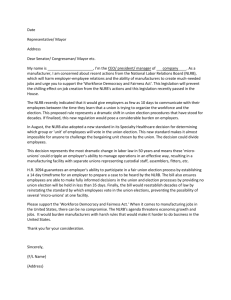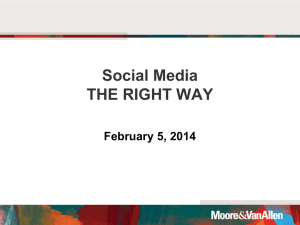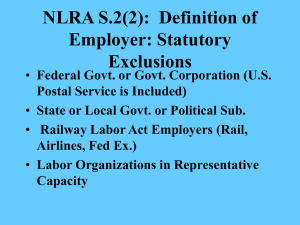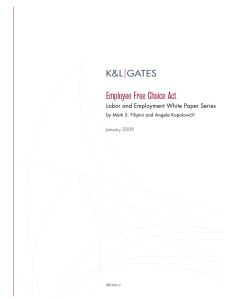Employee Free Choice Act - American Society for Healthcare
advertisement
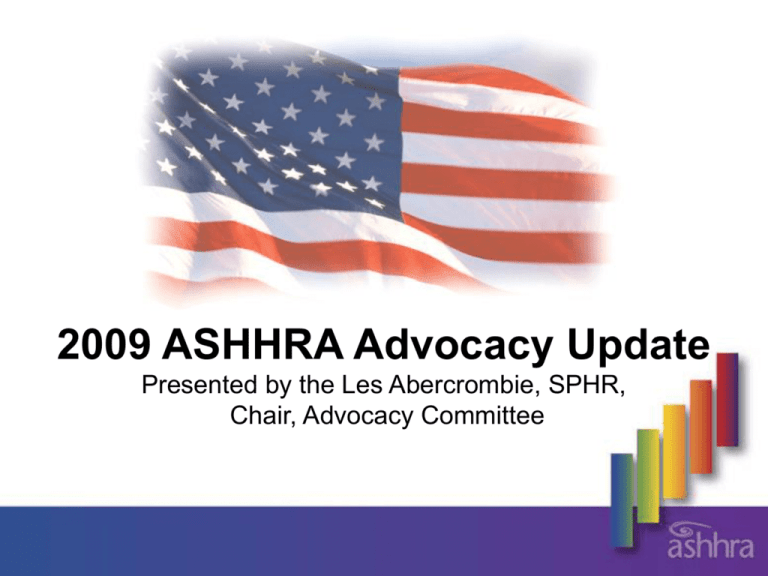
2009 ASHHRA Advocacy Update Presented by the Les Abercrombie, SPHR, Chair, Advocacy Committee Overview Your AC Legislative Update Hill Visit 2009 Advocacy for the ASHHRA Leader Your National Advocacy Committee Committee Charge The Advocacy Committee monitors national and state legislative and labor developments and researches, develops, and promotes advocacy programs that represent the interests of the membership, human resources professionals, and the healthcare industry. Committee Members: Les Abercrombie, Chair Mike Paruta (Region 1) Marcia Telthorster (Region 2) Lee Byrd (Region 3) Jamie Parsons (Region 4) Doug Jontz (Region 5) Steve Hodges (Region 6) Open (Region 7) Barb Hodges (Region 8) Gail Blanchard-Saiger (Region 9) Roger King (At-Large) Staff Liaison: Stephanie Drake Staff Liaison: Cathy Sewell AHA Liaison: Carla Luggiero Washington Update Labor Issues in the 111th Congress March, 2009 Labor ‘s “Wish List” • • • • • • • • • • Card check Supervisor issue Manual lifting FMLA Expansions Employer Neutrality Block Nurse Immigration Employment Verification Ergonomics Staffing ratios Mandatory overtime Labor PACs PAC Spending • • • • • • • • • • • SEIU January 1, 2007 thru August 21, 2008 22.1 million AFSCME 11.5 million Teamsters (IBT) 8.9 million AFT (teachers) 7.5 million Electrical workers (IBEW) 6.8 million Postal workers (APWU) 5.5 million Auto workers (UAW) 4.9 million Food & commercial worker (UFCW) 4.9 million NYS United Teachers 4.9 million Communications workers (CWA) 4.5 million IBEW Local Union 98 (Philadelphia) 4.1 million Math on Card Check Democrats Need 60 to Stop Filibuster • Democrats (58)…includes: – Two independents: Joe Lieberman (CT) Bernie Sanders (VT) • Republicans (41) • Undecided – Minnesota Coleman (R) vs. Franken (D) Math on Card Check Focus • Focus on potential Democrats up • in 2010 and/or from right-to-work states*: – – – – – – – – – – – – – – – – – – Max Baucus (MT) Evan Bayh (IN) Michael Bennet (CO) Jeff Bingaman (NM) Kent Conrad (ND)* Byron Dorgan (ND)* Diane Feinstein (CA) Kay Hagen (NC)* Herb Kohl (WI) Mary Landrieu (LA)* Blanche Lincoln (AR)* Claire McCaskill (MO) Ben Nelson (NE)* Mark Pryor (AR)* Jon Tester (MT) Mark Udall (CO) Mark Warner (VA)* Jim Webb (VA)* Ensure all Republicans remain firm: – – – – Susan Collins (ME) Olympia Snowe (ME) Arlen Specter (PA) George Voinovich (OH) FOR CLOTURE: 57 AGAINST CLOTURE: 42 EFCA – HR 1409/S 560 “Card Check” Key Provisions • H.R 1409/S. 560 introduced 3/10/09 • Last Congress, passed House 241-185 • Stalled in Senate on 6/26/07 – 51-48 • Veto threat • LABOR’S #1 PRIORITY Employee “Free Choice” Act Eliminates federally-supervised private election option under NLRB Amends NLRA to allow a union to present a majority of union-solicited, signed union authorization cards directly to NLRB for certification as the employee’s exclusive bargaining representative. Employee “Free Choice” Act Mandates first-contract binding arbitration where the parties cannot or do not agree after 120 days – 90 days of bargaining – and 30 days of federal mediation – Contract binding for 2 years Employee “Free Choice” Act Strengthens enforcement by imposing penalties and punitive sanctions rather than “make whole” remedies for employer violations – $20,000 per employer violation – Reinstatement with triple back-pay – Mandatory injunctions imposed for unfair labor practices during organizing The Current System • Current Law – Card Check Recognition – Union solicits employee signatures on union authorization cards. Once union has collected minimum of 30% of all eligible workers, petitions NLRB for election. Employer may recognize union. – If employer refuses to recognize union, NLRB schedules secret ballot election • Current Law – Union Elections – Election generally occurs 6 – 7 weeks after union files petition – If majority of workers vote, through secret ballot, to support the union, company must begin bargaining with union – If workers vote union down, union must cease organizing activities “Card Check” How “Card Check” would work under Employee Free Choice Act • Organizers would solicit employee signatures on authorization cards • Once cards signed by 50% plus 1 workers, employer and NLRB must immediately recognize union as exclusive bargaining agent for employees • NLRB is barred from conducting election Differences Between Current and Pending Laws CURRENT NLRB PROCESS PROPOSED EFCA PROCESS Secret ballot No secret ballot No fear of social stigma or retribution Potential harassment, peer pressure and retribution Private voting Public knowledge of position Opportunity to decide future thru voting process May not have opportunity to decide destiny if not contacted by union Procedural safeguards to ensure only votes that count are cast No procedural safeguards against fraudulent cards Government supervised process Union supervised process Opportunity to accept or reject contract Employee removed from bargaining process Organization and union mutually agree on contract terms Arbitrator-imposed binding contract without an employee vote EFCA’s Prospects in the Present Congress • At least seven (7) Democratic Senators have recently stated that they cannot support EFCA in its present form—Senator Voinovich is a “No” on EFCA and Senator Brown from Ohio is a “Yes.” • Potential compromise in addition to Canadian style expedited elections is a graduated card check approach, i.e., 50% to 75% card signing only would trigger an election. Cards submitted in excess of 75% would bypass the election process and require employer recognition. • Is EFCA a “stalking horse” for other labor friendly legislation or regulation, e.g., Obama’s 2009 new Executive Orders? • Obama administration priorities and timing Employee Free Choice Act • Coalition established to: – Educate members of Congress re: impact of bill on employers – Develop a coordinated lobbying effort – Education the public • www.myprivateballot.org “RESPECT” Act Alters Definition of “Supervisor” under NLRA to enable them to be union-eligible Key Provisions • Removes “assigning” and “directing” other staff from functions of “supervisor” under NLRA • Majority of supervisor’s work time spent on remaining statutory duties “RESPECT” Act The term “supervisor” means any individual having authority, in the interest of the employer and for a majority of the individual’s worktime, to hire, transfer, suspend, lay off, recall, promote, discharge, assign, reward, or discipline other employees, or responsibility to direct them, or to adjust their grievances, or effectively to recommend such action, if in connection with the foregoing the exercise of such authority is not of a merely routine or clerical nature, but requires the use of independent judgment. [29 USC §152(11)] “RESPECT” Act • AHA/ASHHRA View – Current labor law is not broken. NLRB decision strikes a reasonable balance in setting criteria for employee vs. supervisor – Bill undermines hospitals’ ability to depend on charge nurse to ensure continuity of care – Will adversely affect patient care in the event of labor strike Nurse and Patient Safety and Protection Act of 2007 Key Provisions • Requires OSHA to establish a federal standard to eliminate all manual lifting of patients • Applies to all health care facilities • Establishes “whistleblower” protections, civil penalties Nurse and Patient Safety and Protection Act of 2007 AHA/ASHHRA View • Protecting our health care staff is a top priority • This is an unreasonably strict approach that could jeopardize proper patient care • Caregivers must have flexibility in making decisions about patient care FMLA Expansions Working Families Flexibility Act • Requires employers to negotiate employee requests which relate to: – Number of required work hours – Times employee is required to work – Where employee is required to work Working Families Flexibility Act • Establishes an extensive appeals process if employee’s request is denied • Employee can trigger a U.S. Department of Labor investigation, ALJ hearing and a federal civil action filed in federal court of appeals • Establishes Remedies against employer Employer Neutrality in Union Organizing The Patriot Employers Act • Includes a provision giving employers a tax incentive who voluntarily agree to remain “neutral” on union matters during a union organizing campaign. Other Labor Issues Ergonomics Restrictions on Overtime Staffing ratios Advocacy Committee Hill Visit May 18-19, 2009 Collaborate with American Hospital Association Partner with SHRM Government Affairs Meet with 20+ Senators/Representatives and staff Advocate on 4 key issues – – – – Protecting employees right to a Secret Ballot RESPECT Act Workforce challenges Protecting Caregivers’ heath and preventing injury Raise Your Voice! Familiarize yourself with the Advocacy Process Understand what is happening on a Federal and State Level Linkage with National AC Set up Chapter AC Work collaboratively with your state hospital association. Advocate on the Legislative Issues that impact the issues important to the health care community Get involved Advocacy Resources National resources: ASHHRA - http://www.ashhra.org American Hospital Association - http://www.aha.org State resources: Your State Hospital Association Your State Legislature Your State ASHHRA Chapter Your State and Local Chambers of Commerce June 24 – 2009 Hill visit webinar Halloween pre-conference session December 3 – Advocacy 101 webinar Pulse Articles Website Online community Raise Your Voice! Familiarize yourself with the Advocacy Process Understand what is happening on a Federal and involved State Level Linkage with National AC Set up Chapter AC Work collaboratively with your state hospital association. Advocate on the Legislative Issues that impact the issues important to the health care community Get Raise Your Voice! Familiarize yourself with the Advocacy Process Understand what is happening on a Federal and State Level Linkage with National AC Set up Chapter AC Work collaboratively with your state hospital association. Advocate on the Legislative Issues that impact the issues important to the health care community Get involved
